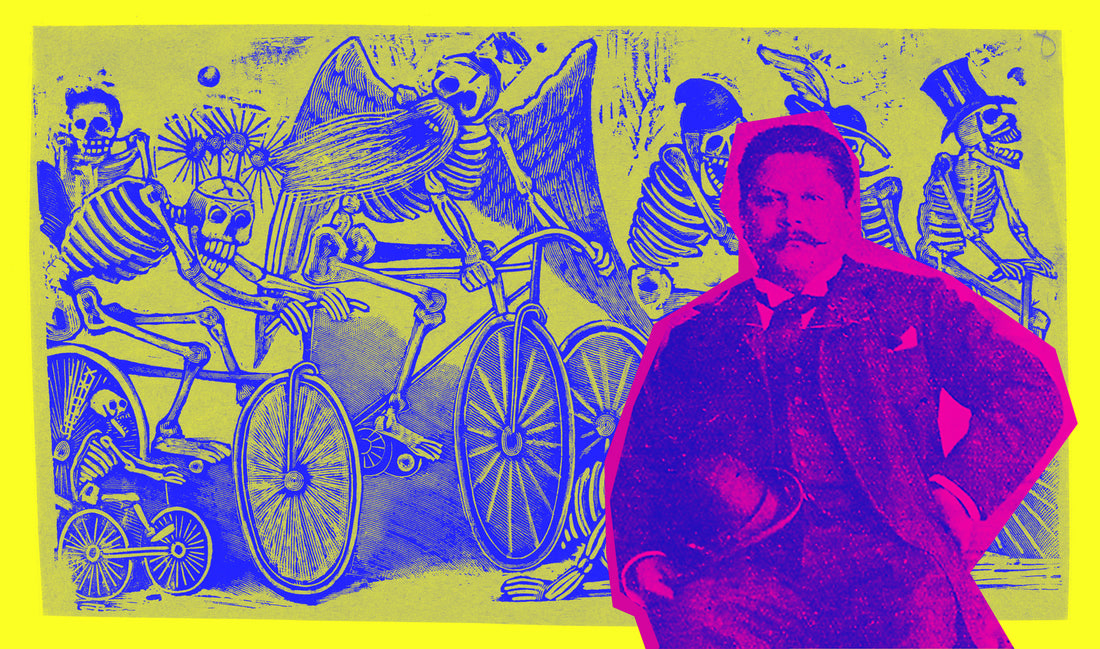The Many Skeleton Illustrations of Mexico's Most Influential Printmaker
José Guadalupe Posada (1852–1913) was a Mexican artist and printmaker who is considered one of the most influential figures in Mexican art at the turn of the twentieth century. His body of work numbered at least sixteen hundred printed images, with some claiming he made as many as twenty thousand prints during his career. Most of his prints took the form of relief engravings printed for mass distribution as broadsheets, posters, and cartoons. Posada's work was often witty and political, providing commentary on Mexican society and culture.
“Death is democratic. At the end, regardless of whether you are white, dark, rich or poor, we all end up as skeletons.” ― José Guadalupe Posada
Posada was best known for his Calaveras, or skeleton illustrations. These illustrations were often biting satire directed at the Mexican upper class before the Revolution. Although Posada didn't invent the idea of depicting dead characters as if they were still alive (see "Calavera Tapatia by Manuel Manilla - Posada's forerunner"↓), his technical perfection set his work apart from others. In this blog post, we'll take a closer look at some of Posada's most interesting illustrations.
Calavera de la Catrina - "La Catrina"

One of Posada's most famous illustrations is "La Catrina". This figure has become symbolic of the Day of the Dead in Mexico and is particularly frequently depicted on it.
The character was created to make fun of the pre-revolutionary Mexican upper class under Porfirio Díaz. The illustrations became particularly popular during the Revolution and have therefore found their way into Mexico's cultural self-representation. 
Woman in Día de los Muertos Makeup by Miguel Gonzalez
Calavera Revolucionaria

Published a few weeks before the official start of the Mexican Revolution, this broadside depicts mounting tensions and violence. A large number of calaveras—including soldiers, politicians, priests, and dentists—lie in a heap on the ground, overwhelming the graveyard. The central figure wielding a machete is dressed as a charro (horseman), which suggests he is working class. This separates him from the dictatorial elite who tended to dress in French-style clothing.

Calaveras del Monton, No. 2

This broadside shows the skeleton of a drunken peon wearing a sombrero, serape, and sandals. The distinctive mustache and beard further identify the calavera as Francisco Madero (Initiator of the Mexican Revolution and President of Mexico 1911 - 1913). Madero's legacy is somewhat controversial, but he is nevertheless considered an important figure in Mexican history. In this illustration, Posada pokes fun at Madero's privileged background. He is holding a bottle of Aguardiente de Parras--a reference to Madero's family's maguey plantation and distillery operation.

El Purgatório Artístico

The main image on the Broadside print shows the second level of hell, where deceased artist and artisans' calaveras are holding objects that relate to their profession. This includes musical instruments and a palette. Below this image is a text block with eight skull illustrations and accompanying verses that provide attributes for each one. The types of skulls and corresponding professions continue onto the back side of the print (verso), along with 16 additional images and attribute verses.

The Bicycle riding Calaveras

This broadside shows calaveras bicycling, with identifying labels, "Voz de México," "Patria," "Universal," "Tiempo," "Partido Liberal," "Gil Blas," names of popular newspapers, and "Siglo XIX," and "Siglo XX." They trample additional calaveras, labeled "Razalatin" and "Quijote." The text block is illustrated with additional skeletons On the verso, there is a large central image which shows calaveras holding sheets paper illustrated with skulls near vendors of religious objects. The text near it reads "And now public will enter an astonishing tranqu, how free they will be from gossiping people." A large skull appears below and the block is illustrated with small skeletons.

La Calavera de Don Quixote

A broadside depicting the skeleton of Don Quixote charging other skeletons on his horse. The scene is one of fear and terror, with many flying into the air in panic. A second image below that of Don Quixote shows calaveras outside a cemetery pursuing a group of young men and women. In addition to these large images, there are smaller decorative elements liberally sprinkled throughout the text block: a bowing skeleton riding a bicycle with a large front wheel and small skeletons pursue soldiers through graveyards.

The great dance of skeletons - Gran baile de calaveras

This broadside rewrites the medieval European story of the Dance of Death with a lighthearted twist. At a party in the graveyard, all types of calaveras — doctors and drunkards, soldiers and washerwomen — come together to dance, eat worms, and drink the tears of grieving mourners. “After death," according to the text," social class or status no longer matter."
Calavera Tapatia by Manuel Manilla - Posada's forerunner

The illustration on the Broadside depicts a male skeleton drinking tequila and smoking a cigar, with various objects lying on the table before him. A child skeleton looks over his shoulder, and six small decorative skulls break up the text. The text is a calavera in verse, extolling the bravery of calaveras from Guadalajara, Jalisco.
Manuel Manilla was born in Mexico City in 1830. He didn't start working as a graphic artist and engraver until 1882 when he was 52 years old, for the publisher Don Antonio Vanegas Arroyo. It wasn't until 1892 that he met José Guadalupe Posada at work and Posada also began working there as a graphic artist. The same year Manilla retired, 1895, he died from typhoid fever.
Manuel Manilla, with his drawings of skeletons performing everyday activities, is considered a forerunner of his short-lived work colleague José Guadalupe Posada. He drew these well-known graphics mainly for sale on the Mexican Dia de los Muertos, the Day of the Dead, every November 2. It is estimated that Manuel Manilla's oeuvre included about 500 different pieces, which also depicted characters from novels, street scenes, and incidents from bullfighting, religion, and magic. However, most of his works are considered lost today.

About Broadsides / Broadsheets
Broadsides were short-lived street literature sold locally for pennies to the masses. Despite their informal nature, broadsides were an important form of communication. They provided critical commentary on the political events of the day otherwise censured in mainstream presses. These days, satirical political commentators like Stephen Colbert and John Stewart are examples of informal but influential media outlets. Likewise, in mid-nineteenth century Mexico, the Venga Arroyo press, where Posada worked, aimed to both inform and entertain the general public on relevant current events.
That's it
I hope you enjoyed the beginning of our blog series "A Closer Look." We're excited to show you more depth and variety in our content and we hope you continue following us as explore different aspects of the topics introduced in our series. How did you like it? Do you have a favorite illustration by Posada? Let us know in the comments below!
Sources:
MoMA | Art & Artists - About José-Guadalupe Posada
Wikipedia - José Guadalupe Posada
The Ohio State University - José Guadalupe Posada Broadsides
Wikipedia - La Catrina
Library of Congress
The New York Public Library


